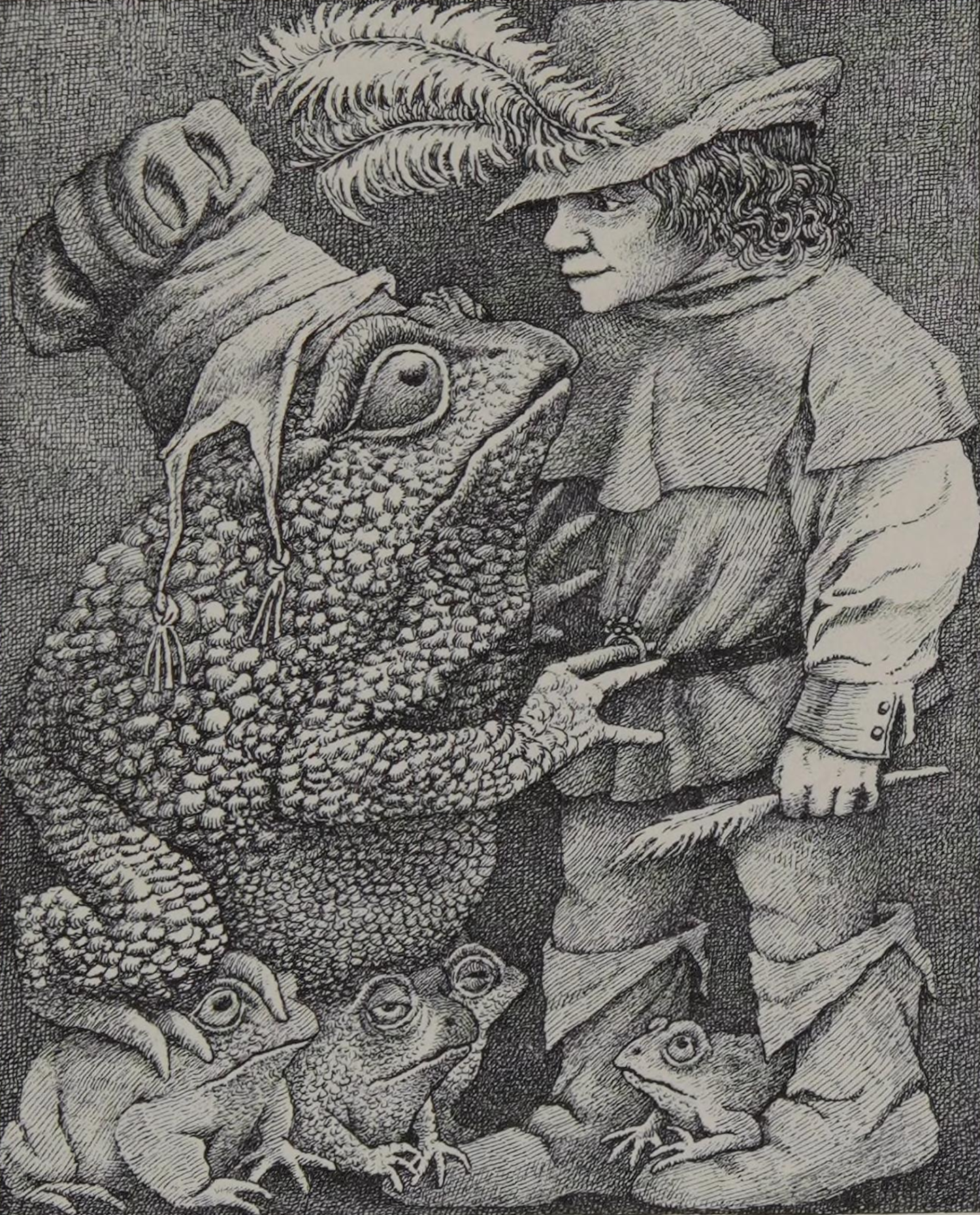"The Three Feathers.” The Juniper Tree, and other Tales from Grimm, Brothers Grimm, translated by Lore Segal, Randall Jarrell, New York: Farrar, Straus and Giroux, 1973, pp. 3-10.

Tale Summary
Once upon a time there was a king who grew old and weak and did not know how to divide up his kingdom amongst his three sons. The eldest two were smart, but the youngest did not speak much and so he was called Dumbkin. He told them to go out into the world, and whoever brought back the finest carpet would be king. The blew three feathers into the air for his sons to choose their direction; the first two went east and west, and Dumbkin’s feather landed on the ground in front of him. He sat down sadly, but noticed a trap door by the feather, and so opened it and climbed down inside. He knocked at another door he came to and was answered by a huge toad surrounded by smaller toads. When Dumbkin asked for a beautiful carpet, one of the young toads fetched him one, and he left after thanking her. The older brothers did not think they would have to travel far to find a carpet, as it would be easy to beat Dumbkin, and so grabbed the rough clothes off the backs of the first shepherd’s wives they met. They all presented their finds and Dumbkin was pronounced the winner. There was much arguing and the old king agreed to a new test, which was that he who brought the most beautiful ring would inherit the kingdom. The feathers blew in the same directions as before, and Dumbkin asked the great toad for what he sought and was given a magnificent ring. The eldest brothers again did not trouble themselves much and each knocked out the iron rings of an old wagon wheel to bring home. Again the youngest won the competition, but the eldest brothers put up such a fuss that another trial was declared. Whoever brought home the most beautiful woman would be king. Dumbkin again went to his toad benefactor and asked this of her, and she gave him a hollow carrot harnessed to six mice, and told him to set one of the tiny toads inside. When he did this, she immediately transformed into a beautiful young lady, and the carrot into a yellow coach, and the mice into horses. The eldest brothers grabbed the first peasant women they came across, who paled in comparison to Dumbkin’s woman, and again he was given the rights to the kingdom. The eldest brothers begged that the prize should go to whoever’s woman was able to jump through a ring that hung down from the middle of the hall, thinking that the peasant women’s strength would be good for something. The old king agreed to this, but the peasant women broke their bones while the toad maiden lept gracefully through. Thus, Dumbkin received the crown.
Fairy Tale Title
The Three Feathers
Fairy Tale Author(s)/Editor(s)
Brothers Grimm, Lore Segal, and Randall Jarrell
Fairy Tale Illustrator(s)
Maurice Sendak
Common Tale Type
The Animal Bride
Tale Classification
ATU 402
Page Range of Tale
pp. 3-10
Full Citation of Tale
"The Three Feathers.” The Juniper Tree, and other Tales from Grimm, Brothers Grimm, translated by Lore Segal, Randall Jarrell, New York: Farrar, Straus and Giroux, 1973, pp. 3-10.
Original Source of the Tale
The Brothers Grimm
Tale Notes
It is noteworthy that in a version of ATU 402, The Animal Bride, there is no mention of the protagonist actually wedding the animal girl.
Tale Audio
[soundcloud width="100%" height="300" scrolling="no" frameborder="no" allow="autoplay" src="https://w.soundcloud.com/player/?url=https%3A//api.soundcloud.com/tracks/1787910352&color=%23ff5500&auto_play=false&hide_related=false&show_comments=true&show_user=true&show_reposts=false&show_teaser=true&visual=true"][/soundcloud]
Research and Curation
Kaeli Waggener, 2024
Book Title
The Juniper Tree, and other Tales from Grimm
Book Author/Editor(s)
Brothers Grimm, translated by Lore Segal and Randall Jarrell
Illustrator(s)
Maurice Sendak
Publisher
Farrar, Straus and Giroux
Date Published
1973
Decade Published
1970-1979
Publisher City
New York
Publisher Country
United States
Language
English
Rights
Copyright not evaluated
Digital Copy
Available at the Internet Archive
Book Notes
Twenty-seven newly translated fairy tales from Grimm (translated from Kinder- und Hausmärchen) including many old favorites as well as such lesser-known tales as "The Juniper Tree," "Many-Fur," and "Brother Gaily." Illustrated by celebrated children's illustrator Maurice Sendak.

